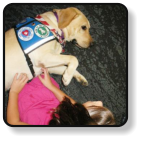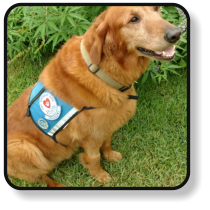

© Paws 4 Hearts Working Therapy Dogs 2014

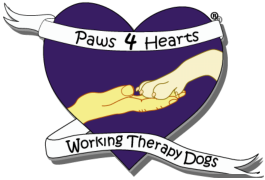
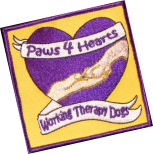
Frequently Asked Questions
What is a therapy dog?
Therapy dogs are household pets whose owners take time to visit hospitals, nursing homes, rehabilitation and other facilities. They help people who have to be away from home due to mental or physical illness, or other reasons. A visit from a therapy dog can brighten the day, lift spirits, and help motivate them in their therapy or treatment with the goal of going home to see their family, friends, and own pets. What does a working therapy dog team do? Below are some of the common types of therapy activities and the programs and events we participate in. Animal-assisted activities (AAA) provide opportunities for motivational, educational and/or recreational benefits to enhance a person’s quality of life. AAA is delivered by professionals, paraprofessionals or volunteers who demonstrate knowledge about animals and the human populations with which they interact. As an example of AAA, an individual brings his or her dog to a long-term care facility to visit the residents. Although the staff is involved in the visits, no treatment goals have been set for the visit and, aside from signing in and out, no records are kept. Animal-assisted therapy (AAT) is a goal-directed intervention in which an animal is incorporated as an integral part of the clinical health-care treatment process. AAT is delivered or directed by a professional health or human service provider who demonstrates skill and expertise regarding the clinical applications of human-animal interactions. Benefits of Animal-Assisted Activities (AAA) and Animal-Assisted Therapy (AAT) are so much more than taking a pet to a hospital. They provide motivational, educational and recreational interactions that enhance people’s quality of life. In one setting, trained volunteers bring their dogs to a long-term care facility to provide residents with mental stimulation, physiological benefits and unconditional acceptance. In other settings, the animal interaction motivates rehabilitation patients to walk again, teaches children in special- education classrooms important life skills, and facilitates counseling sessions in mental health centers. Post Traumatic Stress Disorder (PTS) and Traumatic Brain Injury (TBI). PTS is caused by living through or seeing a traumatic even, such as war, a hurricane, rape, physical abuse or a bad accident. It affects lives of not only the person, but those around them. Many military men and women are experiencing this upon returning from the wars in Iraq and Afghanistan. Patients suffering from this illness have flashbacks, trouble sleeping, anger outbursts, and feelings of worry, guilt or sadness. Specially trained therapy dogs work with these wounded warriors returning from deployment to provide safety and comfort during the healing process. The Reading Education Assistance Dogs (R.E.A.D.) program improves children's reading and communication skills by employing a powerful method: reading to a dog. But not just any dog. R.E.A.D. dogs are registered therapy animals who volunteer with their owner/handlers as a team, going to schools, libraries and many other settings as reading companions for children. The Yellow Ribbon Program (YRP) is a DoD-wide effort to help National Guard and Reserve Service members and their families connect with local resources before, during, and after deployments, especially during the reintegration phase that occurs months after Service members return home. Commanders and leaders play a critical role in assuring that Reserve Service members and their families attend Yellow Ribbon Events where they can access information on health care, education/training opportunities, financial, and legal benefits. The DoD works in conjunction with Federal partners, including the Small Business Administration and Departments of Labor and Veterans Affairs, to provide up-to-date and relevant information to the members of the all-volunteer force and their families.What is the difference between a therapy dog and a service dog?
People are most familiar with dogs classified as service or assistance dogs. Service dogs are trained for assistance to the specific needs of their owners, such as audio or visual impairment, mobility assistance, allergy or seizure response, and some pyschiatric disorders. Service dogs are selected as puppies to begin the significant training that is required to be of assistance to their owners in this capacity. They must be intelligent, reliable, obedient, and able to respond calmly in stressful situations. A therapy dog is quite different from an assistance dog or service dog in the specifics of the help it provides, and also in the qualities necessary to make a particular dog successful in its role. Therapy dogs must be calm, affectionate, gentle, and friendly. Therapy dogs address psychological and social needs by providing comfort and affection to those who need it. Their role is to provide comfort and companionship to people who are staying in hospitals, nursing homes, etc. Therapy dogs visit and provide affection and stimulation, which provides emotional support and can make a big difference in the life of the people that they visit.Can I volunteer without a dog?
Absolutely! We are always looking for volunteers to assist with special events and for helping with regular group tasks. From passing out brochures, setting up tables, website design/maintenance, marketing, social media - just to name a few. Just tell us what your talents are and we'll tell you how you can contribute. Volunteers must be at least 13 years of age. Volunteers between 13-17 years of age must also have a parent or guardian willing to volunteer with them.So, what does it take to be a working therapy team?
It’s important to know what pet therapy involves when deciding whether you and your dog would make a good therapy team. See What It Takes for more information.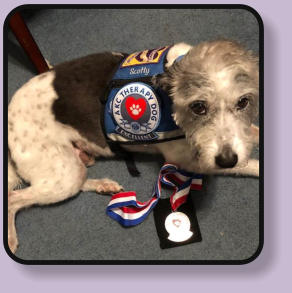
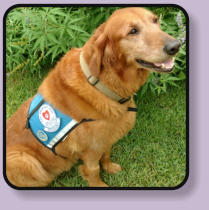


© Paws 4 Hearts Working Therapy Dogs 2014



Frequently Asked Questions
What is a therapy dog?
Therapy dogs are household pets whose owners take time to visit hospitals, nursing homes, rehabilitation and other facilities. They help people who have to be away from home due to mental or physical illness, or other reasons. A visit from a therapy dog can brighten the day, lift spirits, and help motivate them in their therapy or treatment with the goal of going home to see their family, friends, and own pets. What does a working therapy dog team do? Below are some of the common types of therapy activities and the programs and events we participate in. Animal-assisted activities (AAA) provide opportunities for motivational, educational and/or recreational benefits to enhance a person’s quality of life. AAA is delivered by professionals, paraprofessionals or volunteers who demonstrate knowledge about animals and the human populations with which they interact. As an example of AAA, an individual brings his or her dog to a long-term care facility to visit the residents. Although the staff is involved in the visits, no treatment goals have been set for the visit and, aside from signing in and out, no records are kept. Animal-assisted therapy (AAT) is a goal-directed intervention in which an animal is incorporated as an integral part of the clinical health-care treatment process. AAT is delivered or directed by a professional health or human service provider who demonstrates skill and expertise regarding the clinical applications of human-animal interactions. Benefits of Animal-Assisted Activities (AAA) and Animal- Assisted Therapy (AAT) are so much more than taking a pet to a hospital. They provide motivational, educational and recreational interactions that enhance people’s quality of life. In one setting, trained volunteers bring their dogs to a long-term care facility to provide residents with mental stimulation, physiological benefits and unconditional acceptance. In other settings, the animal interaction motivates rehabilitation patients to walk again, teaches children in special-education classrooms important life skills, and facilitates counseling sessions in mental health centers. Post Traumatic Stress Disorder (PTS) and Traumatic Brain Injury (TBI). PTS is caused by living through or seeing a traumatic even, such as war, a hurricane, rape, physical abuse or a bad accident. It affects lives of not only the person, but those around them. Many military men and women are experiencing this upon returning from the wars in Iraq and Afghanistan. Patients suffering from this illness have flashbacks, trouble sleeping, anger outbursts, and feelings of worry, guilt or sadness. Specially trained therapy dogs work with these wounded warriors returning from deployment to provide safety and comfort during the healing process. The Reading Education Assistance Dogs (R.E.A.D.) program improves children's reading and communication skills by employing a powerful method: reading to a dog. But not just any dog. R.E.A.D. dogs are registered therapy animals who volunteer with their owner/handlers as a team, going to schools, libraries and many other settings as reading companions for children. The Yellow Ribbon Program (YRP) is a DoD-wide effort to help National Guard and Reserve Service members and their families connect with local resources before, during, and after deployments, especially during the reintegration phase that occurs months after Service members return home. Commanders and leaders play a critical role in assuring that Reserve Service members and their families attend Yellow Ribbon Events where they can access information on health care, education/training opportunities, financial, and legal benefits. The DoD works in conjunction with Federal partners, including the Small Business Administration and Departments of Labor and Veterans Affairs, to provide up-to-date and relevant information to the members of the all-volunteer force and their families.What is the difference between a therapy dog and a
service dog?
People are most familiar with dogs classified as service or assistance dogs. Service dogs are trained for assistance to the specific needs of their owners, such as audio or visual impairment, mobility assistance, allergy or seizure response, and some pyschiatric disorders. Service dogs are selected as puppies to begin the significant training that is required to be of assistance to their owners in this capacity. They must be intelligent, reliable, obedient, and able to respond calmly in stressful situations. A therapy dog is quite different from an assistance dog or service dog in the specifics of the help it provides, and also in the qualities necessary to make a particular dog successful in its role. Therapy dogs must be calm, affectionate, gentle, and friendly. Therapy dogs address psychological and social needs by providing comfort and affection to those who need it. Their role is to provide comfort and companionship to people who are staying in hospitals, nursing homes, etc. Therapy dogs visit and provide affection and stimulation, which provides emotional support and can make a big difference in the life of the people that they visit.Can I volunteer without a dog?
Absolutely! We are always looking for volunteers to assist with special events and for helping with regular group tasks. From passing out brochures, setting up tables, website design/maintenance, marketing, social media - just to name a few. Just tell us what your talents are and we'll tell you how you can contribute. Volunteers must be at least 13 years of age. Volunteers between 13-17 years of age must also have a parent or guardian willing to volunteer with them.So, what does it take to be a working therapy team?
It’s important to know what pet therapy involves when deciding whether you and your dog would make a good therapy team. See What It Takes for more information.